北师大版(2019)选择性必修第二册Unit 4 Humour Lesson 1 What’s So Funny?课件(共32张)
文档属性
| 名称 | 北师大版(2019)选择性必修第二册Unit 4 Humour Lesson 1 What’s So Funny?课件(共32张) |  | |
| 格式 | pptx | ||
| 文件大小 | 3.1MB | ||
| 资源类型 | 教案 | ||
| 版本资源 | 北师大版(2019) | ||
| 科目 | 英语 | ||
| 更新时间 | 2024-10-26 17:56:02 | ||
图片预览


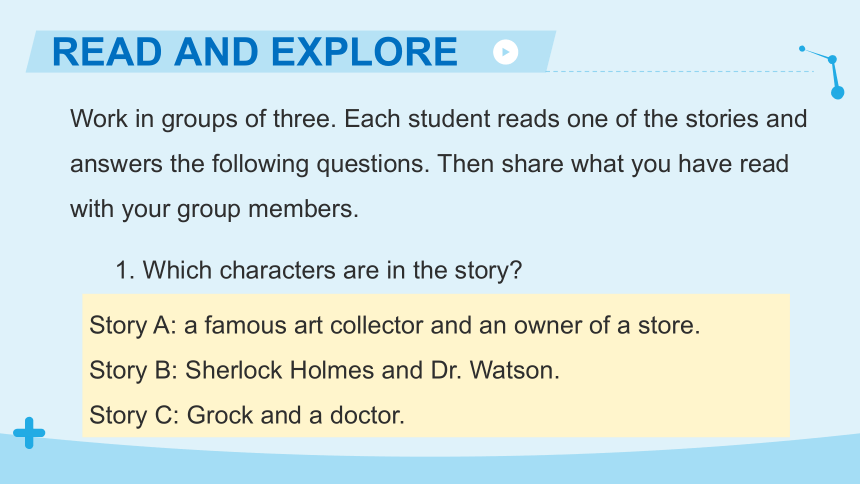
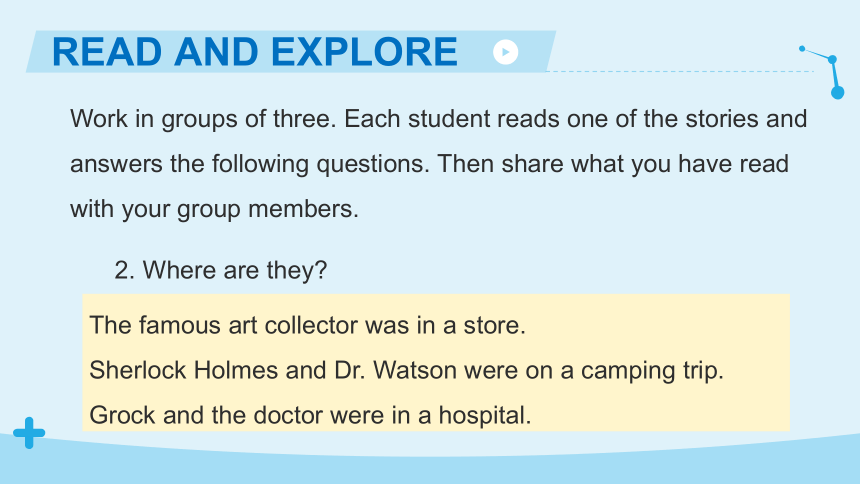

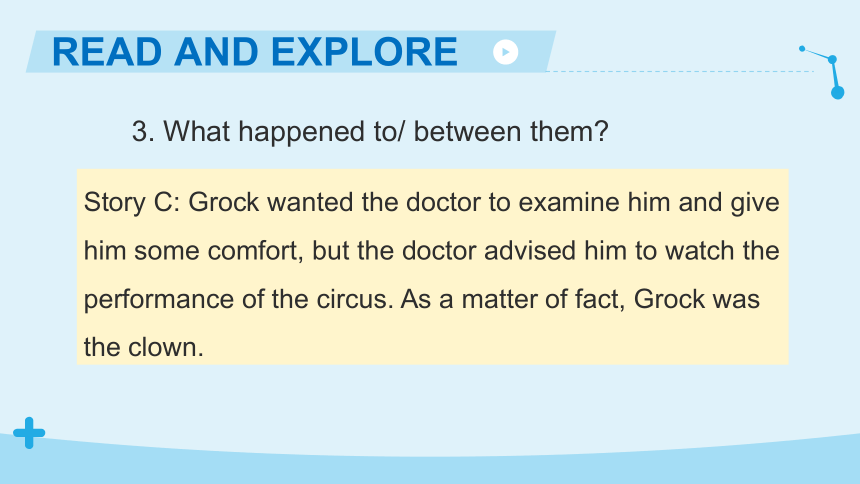

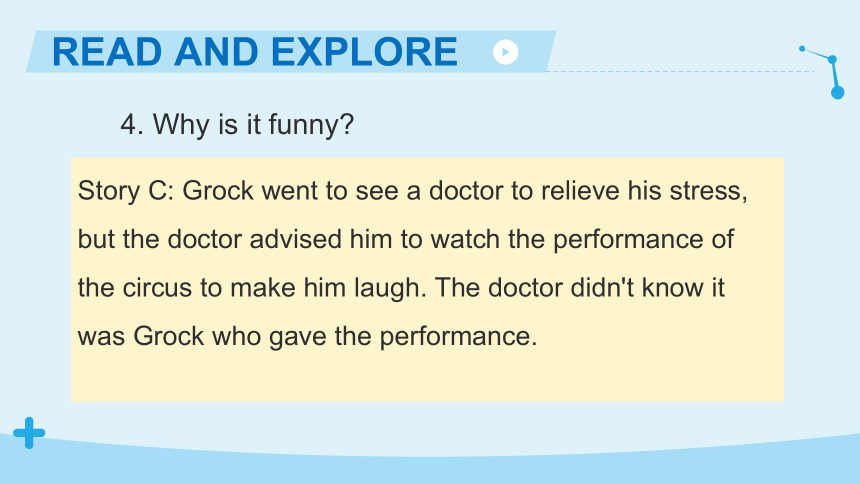
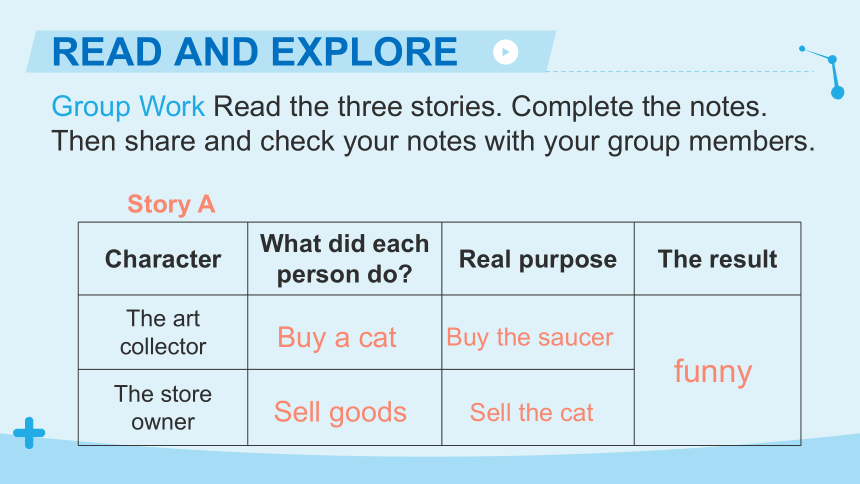

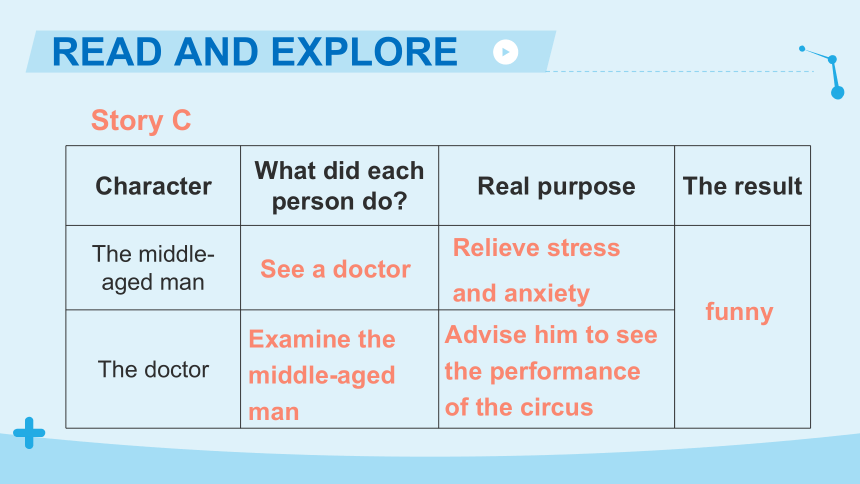
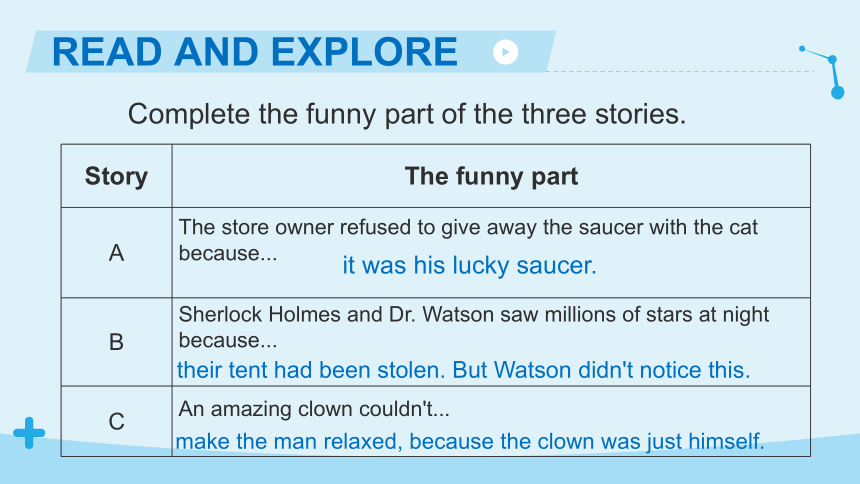
文档简介
(共32张PPT)
Unit 4 Humour
Lesson 1 What's So Funny
Leading in
ACTIVATE AND SHARE
Do you like reading humorous or funny stories Why
Example I like reading humorous stories because I like the play on words.
READ AND EXPLORE
Work in groups of three. Each student reads one of the stories and answers the following questions. Then share what you have read with your group members.
1. Which characters are in the story
Story A: a famous art collector and an owner of a store.
Story B: Sherlock Holmes and Dr. Watson.
Story C: Grock and a doctor.
READ AND EXPLORE
Work in groups of three. Each student reads one of the stories and answers the following questions. Then share what you have read with your group members.
2. Where are they
The famous art collector was in a store.
Sherlock Holmes and Dr. Watson were on a camping trip.
Grock and the doctor were in a hospital.
READ AND EXPLORE
3. What happened to/ between them
Story A: The famous art collector wanted to buy the valuable saucer. And the owner of the shop only wanted to sell the cat.
Story B: Sherlock Holmes wanted to tell Dr. Watson that their tent had been stolen. But Dr. Watson described more about the universe.
READ AND EXPLORE
3. What happened to/ between them
Story C: Grock wanted the doctor to examine him and give him some comfort, but the doctor advised him to watch the performance of the circus. As a matter of fact, Grock was the clown.
READ AND EXPLORE
4. Why is it funny
Story A: The collector had planned to buy the saucer, but in fact he bought a cat.
Story B: Sherlock had planned to make Watson know their tent had been stolen, but Watson didn't notice that.
READ AND EXPLORE
4. Why is it funny
Story C: Grock went to see a doctor to relieve his stress, but the doctor advised him to watch the performance of the circus to make him laugh. The doctor didn't know it was Grock who gave the performance.
READ AND EXPLORE
Group Work Read the three plete the notes. Then share and check your notes with your group members.
Character What did each person do Real purpose The result
The art collector
The store owner Story A
Buy a cat
Sell goods
Buy the saucer
Sell the cat
funny
READ AND EXPLORE
Character What did each person do Real purpose The result
Sherlock Holmes
Dr. Watson Story B
Ask Watson to look up
at the sky and tell him
what he saw
funny
Look up at the sky
Tell Watson their tent had been stolen
Show off what he knew about the universe
READ AND EXPLORE
Character What did each person do Real purpose The result
The middle-aged man
The doctor Story C
See a doctor
funny
Examine the middle-aged man
Relieve stress and anxiety
Advise him to see the performance of the circus
READ AND EXPLORE
Complete the funny part of the three stories.
Story The funny part
A The store owner refused to give away the saucer with the cat because...
B Sherlock Holmes and Dr. Watson saw millions of stars at night because...
C An amazing clown couldn't...
it was his lucky saucer.
their tent had been stolen. But Watson didn't notice this.
make the man relaxed, because the clown was just himself.
READ AND EXPLORE
Group Work
Tell one of the three stories to your group based on your notes
READ AND EXPLORE
Explore two methods of creating humour
1. Play on words—pun
An amusing use of a word or phrase that has two meanings, or of words that have the same sound but different meanings.
双关语最能发挥人的幽默和风趣。法国大文豪雨果也说:“双关语是飞舞着的灵魂的产物。”
READ AND EXPLORE
Explore two methods of creating humour
双关语指在一定的语言环境中,利用词的多义和同音的条件,有意使语句具有双重意义,言在此而意在彼的修辞方式。双关可使语言表达得含蓄、幽默,而且能加深语意,给人以深刻印象。双关可分为谐音双关和语义双关两类。
READ AND EXPLORE
Explore two methods of creating humour
2. Sarcasm
Sarcasm generally takes the form of an ironic remark, somewhat rooted in humour, that is intended to mock or satirize something. When a speaker is being sarcastic, he is saying something different than what he actually means.
READ AND EXPLORE
Explore two methods of creating humour
As a literary device, sarcasm can convey a writer and/or character's true feelings of frustration, anger, and even derision, though veiled by the presence of humour and wording that is inconsistent with what is intended. However, since sarcastic statements, as they are worded, contradict the speaker's intent and true meaning, it can be difficult for writers to effectively utilize this literary device without proper context or tone.
READ AND EXPLORE
Explore two methods of creating humour
讽刺是一种文学手法,用于暴露对象的缺点和可笑之处,常采用夸张或反讽等方式,从而产生幽默的效果。有时用讥刺和嘲讽笔法描写敌对的、落后的事物,有时用夸张的手法加以暴露,以达到贬低的效果。
READ AND EXPLORE
Explore two methods of creating humour
这就是说作者在真实的基础上,以讽刺和嘲讽的手法,揭露某些现象,批判某种行为,使人在会心的笑声中予以否定,这种手法就是讽刺。
讽刺手法犀利有力,而且使用灵活,或正面进攻,或旁敲侧击,或讽刺揶揄,或正颜厉色,嬉笑怒骂,皆成文章。归纳起来,讽刺手法大致有以下几种:
READ AND EXPLORE
Explore two methods of creating humour
(1)漫画法
漫画式的讽刺手法其特点是夸张,把人或事的假、丑、恶加以扩大或缩小,使之变相、变形,以突出这一侧面的特征,达到讽刺的目的。马克·吐温的《竞选州长》采用了这种手法,揭露不同社会的光怪陆离现象,在刻画人物形象方面起了重要作用。
READ AND EXPLORE
Explore two methods of creating humour
(2)对比法
即把被讽刺的对象,在对待同一人或事的前后不同的言行进行描述,以显示被讽刺对象的愚蠢可笑。莫泊桑的《我的叔叔于勒》围绕于勒有无金钱,描写菲力普夫妇言行、态度,前后判若两人的变化,使读者不难看出夫妇二人的极度虚伪、冷酷无情,进一步揭示了资本主义社会人与人之间赤裸裸的金钱关系。契诃夫的《变色龙》通过描写警官奥楚蔑洛夫围绕狗的主人是谁的易变、善变,无情地揭露了沙皇统治下社会的黑暗。
READ AND EXPLORE
Explore two methods of creating humour
(3)托物法
这是一种把讽刺对象比作某物,使讽刺对象具体化、形象化的手法。《惠子相梁》中的惠子听信传言,以为庄子来代他为相,非常恐惧。而庄子却给他讲了一个风趣的故事,他在故事中把自己比作鹓鶵(古代传说中像凤凰一样的鸟),惠子比作猫头鹰,梁国则比作腐鼠。他极力描写了鹓鶵高尚的志趣,而猫头鹰得一腐鼠便视为珍贵美味,讽刺之意溢于言表。这种技法在诸子百家著作及《战国策》中屡有所见。
READ AND EXPLORE
Explore two methods of creating humour
(4)反说法
反说法也就是“说反话”。作为讽刺手段的“反话”,是指用肯定、赞美的语言描述明显的丑恶、虚假的现象,表达作者的鄙视与挖苦。《藤野先生》开头一段对“清国留学生”的描写,表达的正是厌恶之极的情感。“实在标致极了”其实是指一点也不标致,称他们标致,是明显的讽刺。当任何指斥的言辞都不足以把愤怒之情表达的酣畅淋漓时,化为反语的讽刺,较之直言指责更为有力,表达的厌恶之情更为强烈。
VOCABULARY
1. pretend
pretend to be 假装成
pretend to do 假装做
pretend to be doing 假装正在做
pretend to have done 假装已经做了
pretend + that从句 假装
练习:They __________ to be friendly with us.
pretend
VOCABULARY
2. anxiety
with anxiety 焦急地
anxious adj. 焦急的,渴望的
be anxious about/ for sb./ sth. 为某人/ 某事担心
be anxious to do sth. 渴望/ 急于做某事
anxiously adv. 焦虑地,不安地
练习:What's the origin of your _________
anxiety
VOCABULARY
3. confused
confusing adj. 令人迷惑的
confuse v. 混淆,困惑
confuse...with... 把……跟……混淆
练习:He is ___________ about this question.
confused
VOCABULARY
4. faithful
faithful adj. 忠实的;忠诚的
a faithful reader 一位忠实的读者
faithful service 忠诚的服务
be faithful to sb./ sth. 对某人/ 某物忠诚
faithfully adv. 忠实地;忠诚地
faith n. 信念;信仰;信心
lose one's faith 失去信心
练习:You know I'm __________ to you.
faithful
VOCABULARY
5. measurement
measure v. 测量 n. 措施,方法
measure by… 用……来衡量
be measured by 通过……测量/ 衡量
be measured in 以……方式测量/ 衡量
measure sb. for sth. 给某人量衣服尺寸
take measures/ steps/ action to do sth. 采取措施做某事
make sth. to sb.'s measure 照某人的尺寸做某物
练习:Accurate ________________ is important in science.
measurement
VOCABULARY
6. scream
scream (out) (in/ with sth.) (因伤痛、害怕和激动等) 尖叫
scream (sth.) (out) (at sb.) (向某人)高声喊/ 大声叫
scream (out) (for sb./ sth.) (为某人/ 某事)高声喊/ 大声叫
练习:He heard the ___________ of the brakes.
scream
VOCABULARY
7. announce
announce v. 宣布,宣告,发表 (决定、计划)
announce sth. 宣告某事
announce +that从句 宣告……
announce sth.to sb. 向某人宣告某事
It is announced+ that从句 据宣布……
announcement n. 宣告
announcer n. 播音员
练习:They are going to ____________ their engagement.
announce
VOCABULARY
8. do a double take
look up to 尊重,尊敬
look back 回头看;回顾
look over 检查
look up 查阅
look down on/ upon 轻视;瞧不起
练习:We ______________________ to solve the problem.
do a double take
Thank you
Unit 4 Humour
Lesson 1 What's So Funny
Leading in
ACTIVATE AND SHARE
Do you like reading humorous or funny stories Why
Example I like reading humorous stories because I like the play on words.
READ AND EXPLORE
Work in groups of three. Each student reads one of the stories and answers the following questions. Then share what you have read with your group members.
1. Which characters are in the story
Story A: a famous art collector and an owner of a store.
Story B: Sherlock Holmes and Dr. Watson.
Story C: Grock and a doctor.
READ AND EXPLORE
Work in groups of three. Each student reads one of the stories and answers the following questions. Then share what you have read with your group members.
2. Where are they
The famous art collector was in a store.
Sherlock Holmes and Dr. Watson were on a camping trip.
Grock and the doctor were in a hospital.
READ AND EXPLORE
3. What happened to/ between them
Story A: The famous art collector wanted to buy the valuable saucer. And the owner of the shop only wanted to sell the cat.
Story B: Sherlock Holmes wanted to tell Dr. Watson that their tent had been stolen. But Dr. Watson described more about the universe.
READ AND EXPLORE
3. What happened to/ between them
Story C: Grock wanted the doctor to examine him and give him some comfort, but the doctor advised him to watch the performance of the circus. As a matter of fact, Grock was the clown.
READ AND EXPLORE
4. Why is it funny
Story A: The collector had planned to buy the saucer, but in fact he bought a cat.
Story B: Sherlock had planned to make Watson know their tent had been stolen, but Watson didn't notice that.
READ AND EXPLORE
4. Why is it funny
Story C: Grock went to see a doctor to relieve his stress, but the doctor advised him to watch the performance of the circus to make him laugh. The doctor didn't know it was Grock who gave the performance.
READ AND EXPLORE
Group Work Read the three plete the notes. Then share and check your notes with your group members.
Character What did each person do Real purpose The result
The art collector
The store owner Story A
Buy a cat
Sell goods
Buy the saucer
Sell the cat
funny
READ AND EXPLORE
Character What did each person do Real purpose The result
Sherlock Holmes
Dr. Watson Story B
Ask Watson to look up
at the sky and tell him
what he saw
funny
Look up at the sky
Tell Watson their tent had been stolen
Show off what he knew about the universe
READ AND EXPLORE
Character What did each person do Real purpose The result
The middle-aged man
The doctor Story C
See a doctor
funny
Examine the middle-aged man
Relieve stress and anxiety
Advise him to see the performance of the circus
READ AND EXPLORE
Complete the funny part of the three stories.
Story The funny part
A The store owner refused to give away the saucer with the cat because...
B Sherlock Holmes and Dr. Watson saw millions of stars at night because...
C An amazing clown couldn't...
it was his lucky saucer.
their tent had been stolen. But Watson didn't notice this.
make the man relaxed, because the clown was just himself.
READ AND EXPLORE
Group Work
Tell one of the three stories to your group based on your notes
READ AND EXPLORE
Explore two methods of creating humour
1. Play on words—pun
An amusing use of a word or phrase that has two meanings, or of words that have the same sound but different meanings.
双关语最能发挥人的幽默和风趣。法国大文豪雨果也说:“双关语是飞舞着的灵魂的产物。”
READ AND EXPLORE
Explore two methods of creating humour
双关语指在一定的语言环境中,利用词的多义和同音的条件,有意使语句具有双重意义,言在此而意在彼的修辞方式。双关可使语言表达得含蓄、幽默,而且能加深语意,给人以深刻印象。双关可分为谐音双关和语义双关两类。
READ AND EXPLORE
Explore two methods of creating humour
2. Sarcasm
Sarcasm generally takes the form of an ironic remark, somewhat rooted in humour, that is intended to mock or satirize something. When a speaker is being sarcastic, he is saying something different than what he actually means.
READ AND EXPLORE
Explore two methods of creating humour
As a literary device, sarcasm can convey a writer and/or character's true feelings of frustration, anger, and even derision, though veiled by the presence of humour and wording that is inconsistent with what is intended. However, since sarcastic statements, as they are worded, contradict the speaker's intent and true meaning, it can be difficult for writers to effectively utilize this literary device without proper context or tone.
READ AND EXPLORE
Explore two methods of creating humour
讽刺是一种文学手法,用于暴露对象的缺点和可笑之处,常采用夸张或反讽等方式,从而产生幽默的效果。有时用讥刺和嘲讽笔法描写敌对的、落后的事物,有时用夸张的手法加以暴露,以达到贬低的效果。
READ AND EXPLORE
Explore two methods of creating humour
这就是说作者在真实的基础上,以讽刺和嘲讽的手法,揭露某些现象,批判某种行为,使人在会心的笑声中予以否定,这种手法就是讽刺。
讽刺手法犀利有力,而且使用灵活,或正面进攻,或旁敲侧击,或讽刺揶揄,或正颜厉色,嬉笑怒骂,皆成文章。归纳起来,讽刺手法大致有以下几种:
READ AND EXPLORE
Explore two methods of creating humour
(1)漫画法
漫画式的讽刺手法其特点是夸张,把人或事的假、丑、恶加以扩大或缩小,使之变相、变形,以突出这一侧面的特征,达到讽刺的目的。马克·吐温的《竞选州长》采用了这种手法,揭露不同社会的光怪陆离现象,在刻画人物形象方面起了重要作用。
READ AND EXPLORE
Explore two methods of creating humour
(2)对比法
即把被讽刺的对象,在对待同一人或事的前后不同的言行进行描述,以显示被讽刺对象的愚蠢可笑。莫泊桑的《我的叔叔于勒》围绕于勒有无金钱,描写菲力普夫妇言行、态度,前后判若两人的变化,使读者不难看出夫妇二人的极度虚伪、冷酷无情,进一步揭示了资本主义社会人与人之间赤裸裸的金钱关系。契诃夫的《变色龙》通过描写警官奥楚蔑洛夫围绕狗的主人是谁的易变、善变,无情地揭露了沙皇统治下社会的黑暗。
READ AND EXPLORE
Explore two methods of creating humour
(3)托物法
这是一种把讽刺对象比作某物,使讽刺对象具体化、形象化的手法。《惠子相梁》中的惠子听信传言,以为庄子来代他为相,非常恐惧。而庄子却给他讲了一个风趣的故事,他在故事中把自己比作鹓鶵(古代传说中像凤凰一样的鸟),惠子比作猫头鹰,梁国则比作腐鼠。他极力描写了鹓鶵高尚的志趣,而猫头鹰得一腐鼠便视为珍贵美味,讽刺之意溢于言表。这种技法在诸子百家著作及《战国策》中屡有所见。
READ AND EXPLORE
Explore two methods of creating humour
(4)反说法
反说法也就是“说反话”。作为讽刺手段的“反话”,是指用肯定、赞美的语言描述明显的丑恶、虚假的现象,表达作者的鄙视与挖苦。《藤野先生》开头一段对“清国留学生”的描写,表达的正是厌恶之极的情感。“实在标致极了”其实是指一点也不标致,称他们标致,是明显的讽刺。当任何指斥的言辞都不足以把愤怒之情表达的酣畅淋漓时,化为反语的讽刺,较之直言指责更为有力,表达的厌恶之情更为强烈。
VOCABULARY
1. pretend
pretend to be 假装成
pretend to do 假装做
pretend to be doing 假装正在做
pretend to have done 假装已经做了
pretend + that从句 假装
练习:They __________ to be friendly with us.
pretend
VOCABULARY
2. anxiety
with anxiety 焦急地
anxious adj. 焦急的,渴望的
be anxious about/ for sb./ sth. 为某人/ 某事担心
be anxious to do sth. 渴望/ 急于做某事
anxiously adv. 焦虑地,不安地
练习:What's the origin of your _________
anxiety
VOCABULARY
3. confused
confusing adj. 令人迷惑的
confuse v. 混淆,困惑
confuse...with... 把……跟……混淆
练习:He is ___________ about this question.
confused
VOCABULARY
4. faithful
faithful adj. 忠实的;忠诚的
a faithful reader 一位忠实的读者
faithful service 忠诚的服务
be faithful to sb./ sth. 对某人/ 某物忠诚
faithfully adv. 忠实地;忠诚地
faith n. 信念;信仰;信心
lose one's faith 失去信心
练习:You know I'm __________ to you.
faithful
VOCABULARY
5. measurement
measure v. 测量 n. 措施,方法
measure by… 用……来衡量
be measured by 通过……测量/ 衡量
be measured in 以……方式测量/ 衡量
measure sb. for sth. 给某人量衣服尺寸
take measures/ steps/ action to do sth. 采取措施做某事
make sth. to sb.'s measure 照某人的尺寸做某物
练习:Accurate ________________ is important in science.
measurement
VOCABULARY
6. scream
scream (out) (in/ with sth.) (因伤痛、害怕和激动等) 尖叫
scream (sth.) (out) (at sb.) (向某人)高声喊/ 大声叫
scream (out) (for sb./ sth.) (为某人/ 某事)高声喊/ 大声叫
练习:He heard the ___________ of the brakes.
scream
VOCABULARY
7. announce
announce v. 宣布,宣告,发表 (决定、计划)
announce sth. 宣告某事
announce +that从句 宣告……
announce sth.to sb. 向某人宣告某事
It is announced+ that从句 据宣布……
announcement n. 宣告
announcer n. 播音员
练习:They are going to ____________ their engagement.
announce
VOCABULARY
8. do a double take
look up to 尊重,尊敬
look back 回头看;回顾
look over 检查
look up 查阅
look down on/ upon 轻视;瞧不起
练习:We ______________________ to solve the problem.
do a double take
Thank you
同课章节目录
- Unit 4 Humour
- Lesson 1 What’s So Funny?
- Lesson 2 Why Do We Need Humour?
- Lesson 3 My Favourite Comedian
- Unit 5 Education
- Lesson 1 Enlightening a Mind
- Lesson 2 The Objectives of Education
- Lesson 3 Understanding
- Unit 6 The Media
- Lesson 1 From Page to Screen
- Lesson 2 Questions about Media
- Lesson 3 The Advertising Game
